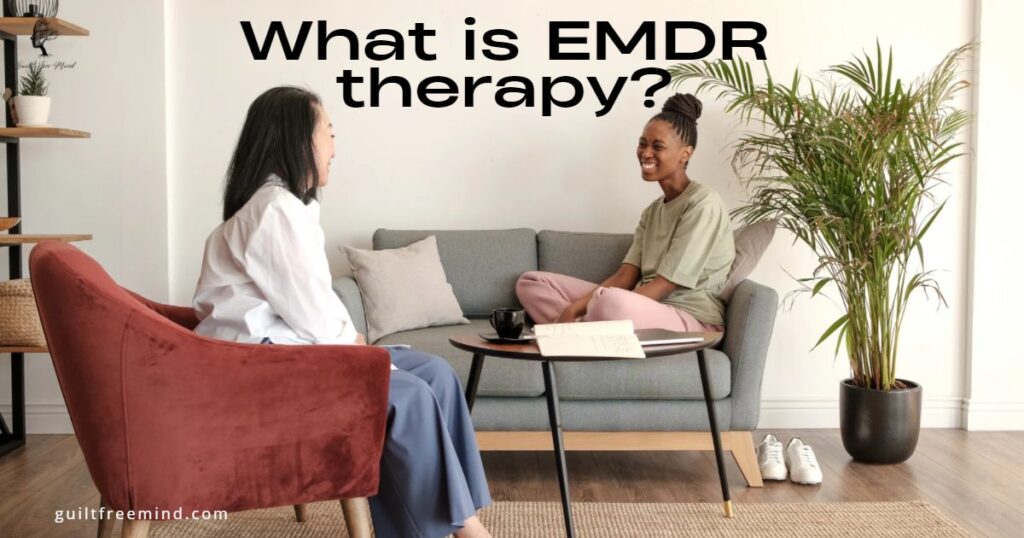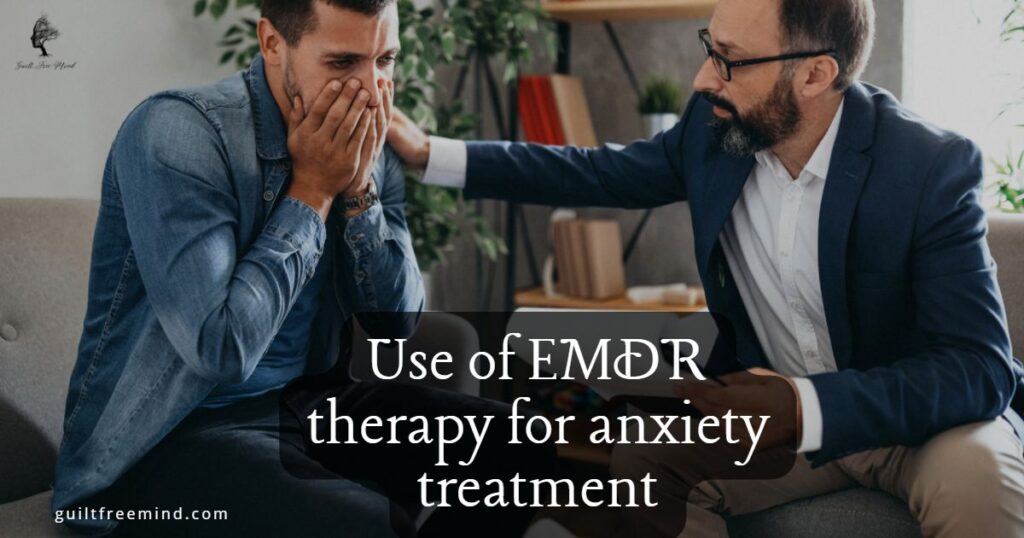In my previous blog post, I discussed what EMDR therapy is and how it works. In this article, I will discuss how EMDR therapy can be used to help patients suffering from anxiety disorders.
If you want to know more about therapeutic techniques to help with anxiety, traumas, toxic relationships or any other psychological issues, subscribe to the Guilt Free Mind. This way, I can notify you about the release of new blog posts. If you like videos, subscribe to the YouTube channel, Shruti’s Art Studio. Do not forget to ring the notification bell.
Table of Contents
What is EMDR therapy?
EMDR [eye movement desensitization and reprocessing] therapy is primarily used to heal patients suffering from past traumas. The patient may have had one or multiple traumatic incidences. The problem arises when situations in the current scenario forces the patient to revisit the past traumatic experiences. Thus, the patient relives the past all over again. EMDR therapy transforms the negatives of traumatic experiences into positives.
With EMDR therapy, if the past resurfaces, it will not be viewed negatively by the patient. Thus, the patient will look at the past in a positive and enlightening manner. This will help the patient move on. He will progress from the traumatic experience into a happier and healthier future.

How can EMDR help patients with anxiety disorders?
Anxiety is not something that one is born with. Anxiety stems from the past. Suppose you have suffered from emotional abuse in the past. In that case, you will feel anxious if a similar situation occurs in your present. EMDR therapy aims to modify your experience itself. Once your mind’s perception of the experience modifies, when the memories from the past resurface, they will not induce anxiety attacks.
How does EMDR therapy work to reduce anxiety?
For EMDR therapy, the psychotherapist will ask the patient to pick a specific incident from the past. Alternatively, the therapist may pick up the incident after a discussion with the patient. The psychologist asks the patient to notice the images, emotions, and sensations they feel when they think about their past.
The therapist will then focus on changing the negative emotions associated with the past into positive emotions. For example, You stop viewing your past as a traumatic experience. Instead, you derive motivation from your experiences and boast in the glory that you successfully survived the trauma. In contrast, so many others succumb to it.
As the negative past experiences change into positive ones, the anxiety reduces, and the patient feels relieved. Even though the past continues to resurface, the patient looks at it more positively instead of viewing it in a negative light.
Benefits of EMDR therapy for anxiety.
Since anxiety stems from repressed childhood trauma, it can be incredibly hard for the patient to describe the traumatic incidences verbally. The primary benefit of opting for EMDR therapy is that the patients need not discuss their painful past. Therefore, this therapy even works with those who have difficulty putting their traumatic issues into words.
The EMDR therapist focuses on using the process of gentle guidance to lead you from the negative viewpoints towards a positive front so that you can find a place that is devoid of anxiety and is abundant in tranquility.

Which of the anxiety disorders can be targeted by EMDR therapy?
According to research, various anxiety disorders have shown success with EMDR therapy. A few of these are:
- Panic disorder
- Generalized anxiety disorder
- Anxiety regarding fear of flying
- Agoraphobia with panic disorder
- Social anxiety
- Obsessive-compulsive disorder
- Phobias
- General performance anxiety
- Performance anxiety in musicians and athletes specifically
- Anxiety of caregivers
- Natural disasters related anxiety
- Medical situations and postoperative care anxiety
Anxiety is similar to PTSD.
You can view anxiety in a similar light as post-traumatic stress disorder. People who suffer from PTSD have been through either childhood trauma or have a traumatic past that continues to resurface when a similar situation occurs. Alternatively, the situation may not have occurred, and the patient may still feel the repercussions of the past. The person may dream about the trauma, suffer through visual or auditory hallucinations, etc. Similarly, in the case of anxiety, it is not necessary that the incidence must repeat itself for the anxiety attack to begin. Anything that mildly relates to the traumatic incident can trigger an anxiety attack. The intensity and the frequency of the anxiety attack will depend on the impact of the traumatic experience on the person.
Use of EMDR therapy for anxiety treatment
During the initial stages of the treatment, the therapist may focus on using meditation, relaxation techniques, mindfulness practices, etc., to increase the efficiency of the treatment process. Many a time, therapists also use cognitive behavioral therapy along with EMDR therapy for the treatment of anxiety in patients.
Meditation can provide immediate relief. EMDR can provide relief in the long term. However, which technique to use to supplement the EMDR therapy is a decision taken by the therapist. This decision depends on the patient’s traumatic experiences and willingness to participate. Therefore, the therapist and patient will work together to develop a personalized plan of treatment for the patient.

The eight-step protocol of treating anxiety by EMDR therapy.
The therapeutic process of EMDR involves eight different phases.
First phase
The first phase primarily focuses on compiling the history of the patient. The therapist understands the traumatic past of the patient. The next step is to identify which memories need to be targeted for the upcoming therapy sessions. In some cases (one trauma incidence), one session is enough for treatment. If there are multiple traumatic incidences, multiple sessions are employed for treatment.
Second phase
The second phase of the EMDR therapy will target the specific memories that the therapist has selected for the therapeutic procedure. The therapist will teach stress reduction techniques to the patient and encourage the patient to use those when under stress.
Third phase
The third phase will focus on transformation. The therapist will identify the visual images of the trauma, the negative self-belief, and the bodily sensations the patient experiences when the trauma comes to mind. The therapist will use bilateral stimulation to redirect the trauma and negative experience of the traumatic past.
The eventual phases will focus on strengthening the coping mechanisms so that the patient can successfully deal with the past traumas if and when they resurface in the future. If at any step it seems that the patient is struggling, the therapist will guide him back on track. The focus will be on the successful processing of the trauma. Once the patient processes one trauma, the therapist will move on to the next trauma.
How is EMDR therapy specifically curtailed to fit the needs of anxiety patients?
Most often, the therapy lasts for an hour. Depending on the severity of the panic attacks, the therapist decides the specific treatment method after a discussion with the patient.
EMDR therapy for phobias
Suppose the patient has a phobia of watching violent scenes in movies. The patient’s history contains domestic abuse. Thus, every time the patient comes across a violent scene on television, it triggers a panic attack. Before the psychotherapist starts the process of EMDR therapy with the patient, he will teach the patient some relaxation techniques. The therapist asks the patient to make use of these relaxation techniques whenever things get tough.
Sometimes, the trauma is so damaging that people cannot put it in words. The therapist may encourage the patient to discuss the trauma part by part. These discussions are intermingled it with stress reduction techniques and breathing exercises. This way, the past can be discussed without going into a full-blown panic attack. The therapist will then focus on identifying certain positive and negative aspects of the experience.

Understanding the effects of trauma
Following this, the therapist will enlighten the patient about how trauma manifests, molds the mind, and interferes with the day-to-day functioning of the patient’s life. Once the patient understands the effect of trauma on the mind and body and has learned certain relaxation techniques, the therapist will encourage the patient to work on the relaxation techniques.
The next step starts once the patient successfully deals with the memory of trauma by using relaxation techniques. Now, the therapist will take the patient’s history. The focus is to learn about the different incidences that have contributed to the patient’s trauma. During the discussion, the therapist will encourage the patient to use relaxation techniques. This helps keep the psychological impact of the past tolerating levels.
When the patient realizes that they can talk easily about the history of trauma, their self-confidence will improve. This will also motivate the patient to proceed with the therapeutic process.
Induction of relaxation techniques
As the therapy goes deeper, the therapist may introduce more relaxation techniques. These techniques include calm imagery, breathing exercises, etc. They will help the patient relax when tackling traumatic memories.
Once the patient starts to open up and discuss the past without panic attacks, the mental and emotional state of the patient will improve. The patient will gain confidence, and the relaxation therapies will help the patient stay in control. This may happen even without the patient realizing it.
Once the patient can successfully discuss past traumas, the therapist will go into the phobia-inducing scenarios. The therapist may ask the patient to bring along an object, animal, or person that helps them feel comfortable. This will allow the therapeutic process to go much faster. With a proper support, the progress is much quicker.
Once the patient has tackled the past traumas, the factor that induces phobia can easily be handled. The same relaxation techniques and imaginary therapies would be applied when the patient looks at the scenarios that induce a phobia.
The desensitization
The decentralization process would begin with small timed intervals of exposure to the scene that induces phobia. For example, initially the therapist will expose the patient to two seconds of the visual footage showing violence. The patient will use the relaxation techniques to curb the anxiety attack. Once the patient has become comfortable viewing 2 seconds of a violent movie scene, the duration will increase. This way, step by step, the patient will learn to handle violent scenes without having a panic attack.
If you have an animal that you are close to, like your dog, you can bring him for your EMDR therapy sessions. Psychologists believe having a comforting presence whom you trust and love can accelerate your therapy and keep you calm.
EMDR therapy for performance anxiety
Suppose a patient suffers from performance anxiety type anxiety disorder. In that case, the therapist will focus on the instances that cause performance anxiety in the patient. Once the triggers have been identified, the therapist will work with the patient to identify how the past instances brought on the performance anxiety. Most often, a few failed performances cause performance anxiety in the patient.
In most cases, performance anxiety is blown out of proportion by people. The therapist works to identify the triggers first. Following this, the therapist will employ the eight-stage protocol of the EMDR therapy to help the patient see those failures in a new light. Once the patient realizes that they were only a few mistakes that brought on the performance anxiety and can be easily tackled, the bilateral stimulation method of the EMDR therapy can be employed to help the brain access the positives of the past incident.
Overall, EMDR therapy can help boost confidence, alleviate past traumas and gain a more positive sense of self. The relaxation techniques and positive beliefs allow the patient to emerge as a stronger, confident individual with a positive attitude.
The success of EMDR therapy is not only dependent on the therapist. The patient must work along with the therapist. He must also follow through with the instructions to notice the change in themselves.

Final thoughts
I hope with the examples mentioned above; you have a better understanding of how EMDR therapy can help patients deal with anxiety. The first part of anxiety treatment is to recognize that you need help. The eight phases of the EMDR therapy can help patients suffering from anxiety and those suffering from past traumas, PTSD, anxiety attacks, etc. If you or your acquaintance are showing signs of anxiety disorder, you should advise them to seek EMDR therapy. Aside from this, you can look into art therapy and sandplay therapy to deal with anxiety disorder.
Do you want to know how EMDR therapy works? How it can help you handle past traumas and other psychological issues? In that case, please subscribe to the Guilt Free Mind. Your subscription will let me notify you the moment I release the next blog post. Thus, you will never miss out on any of the new releases. If you like videos, please subscribe to the YouTube channel of Guilt Free Mind and ring the notification bell. YouTube will let you know when there is a new video release.
Have you tried EMDR therapy? What are your thoughts about this therapeutic process? Please mention your opinions, views, and experiences in the comment section below. Your experiences may encourage others to go for EMDR therapy who might benefit from it. Never underestimate the power of your opinion. If you have any queries about this blog post or any other on Guilt Free Mind, please reach out to me on any of my social media channels. You can also contact me via the contact form, comment section, or mail me.
See you in my next blog post
Pin this article for later

Frequently Asked Questions
Eye movement desensitization reprocessing (EMDR) therapy has shown to be successful in treating a wide variety of psychological issues like past trauma, anxiety, PTSD etc.
The eight phases of EMDR therapy have been observed to help patients suffering from a variety of anxiety disorders like panic attacks, OCD, performance anxiety etc.
EMDR therapy can successfully cure anxiety. There are many cases in support of the same. The therapy along with meditation and other relaxation techniques can help cure anxiety in a few settings depending on the severity of the past incidences.

22 Comments
I agree with your point of view, your article has given me a lot of help and benefited me a lot. Thanks. Hope you continue to write such excellent articles.
I agree with your point of view, your article has given me a lot of help and benefited me a lot. Thanks. Hope you continue to write such excellent articles.
Very well presented. Every quote was awesome and thanks for sharing the content. Keep sharing and keep motivating others.
I have read your article carefully and I agree with you very much. This has provided a great help for my thesis writing, and I will seriously improve it. However, I don’t know much about a certain place. Can you help me?
This is really interesting, You’re a very skilled blogger. I’ve joined your feed and look forward to seeking more of your magnificent post. Also, I’ve shared your site in my social networks!
I like the efforts you have put in this, regards for all the great content.
Hi there to all, for the reason that I am genuinely keen of reading this website’s post to be updated on a regular basis. It carries pleasant stuff.
I’m often to blogging and i really appreciate your content. The article has actually peaks my interest. I’m going to bookmark your web site and maintain checking for brand spanking new information.
I appreciate you sharing this blog post. Thanks Again. Cool.
I truly appreciate your technique of writing a blog. I added it to my bookmark site list and will
This was beautiful Admin. Thank you for your reflections.
Your writing is clear and concise, and your ideas are well-supported with evidence. This is a great example of how to present complex ideas in an easy-to-understand way.
Hi there to all, for the reason that I am genuinely keen of reading this website’s post to be updated on a regular basis. It carries pleasant stuff.
I do not even understand how I ended up here, but I assumed this publish used to be great
I am truly thankful to the owner of this web site who has shared this fantastic piece of writing at at this place.
I truly appreciate your technique of writing a blog. I added it to my bookmark site list and will
There is definately a lot to find out about this subject. I like all the points you made
There is definately a lot to find out about this subject. I like all the points you made
very informative articles or reviews at this time.
Cool that really helps, thank you.
I just like the helpful information you provide in your articles
This is really interesting, You’re a very skilled blogger. I’ve joined your feed and look forward to seeking more of your magnificent post. Also, I’ve shared your site in my social networks!